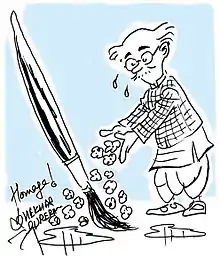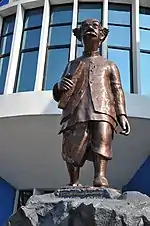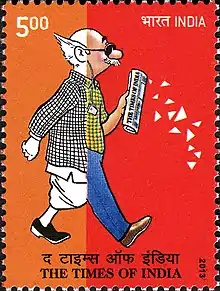| The Common Man | |
|---|---|
 The Common Man in a tribute to R. K. Laxman by Shekhar Gurera | |
| Publication information | |
| Publisher | The Times of India |
| First appearance | You Said It (1951) |
| Created by | R. K. Laxman |
| In-story information | |
| Species | Human |
| Place of origin | India |
The Common Man is a cartoon character created by Indian author and cartoonist R. K. Laxman. For over a half of a century, the Common Man has represented the hopes, aspirations, troubles and perhaps even foibles of the average Indian, through a daily comic strip, You Said It in The Times of India. The comic was started in 1951.[1]
When Laxman began to draw cartoons in The Times of India, he attempted to represent different states and cultures in India. In the rush to meet deadlines, he began to draw fewer and fewer background characters, until finally he found only one remaining—the now-familiar Common Man. The Common Man generally acts as a silent witness to all the action in the comic. According to anthropologist Ritu Gairola Khanduri, "Clad in a dhoti and a plaid jacket, the puzzled Common Man is no dupe: his sharp observations miss no detail of the political circus."[2]
Other depictions
- The Common Man featured in a commemorative postage stamp released by the Indian Postal Service on the 150th anniversary of the Times of India in 1988. It became one of the most recognised feature on The Times of India the largest-circulation English language daily broadsheet newspaper in the world.
- On 24 October 2015, Google featured the Common Man on a Google Doodle to honour R. K. Laxman on the occasion of his 94th birthday.[3]
- The Common Man was the mascot for the low budget airline Air Deccan.[4]
- The character was adapted into the Indian television series Wagle Ki Duniya on DD National and R K Laxman Ki Duniya on SAB TV.[5]
- Salman Rushdie, who grew up in Bombay on a daily fare of Laxman's pocket cartoons, mentions the Common Man in two of his books—his 1995 novel The Moor's Last Sigh and his 2012 autobiography, Joseph Anton.[6]
Statues

- An 8.2 feet high[7] bronze statue of "The Common Man" has been erected at the Symbiosis Institute, Pune in front of its Vishwabhavan building. The Common Man has a wisp of white hair that is perpetually standing, leaving him with a bewildered look.[8]
- A statue of The Common Man, created by the sculptor Suresh Sakpal, was installed in 2007 along the sea face on Khan Abdul Ghaffar Khan road, Worli seaface, Mumbai.[9][10][11][12]
- A statue of The Common Man is erected at the entrance of R. K. Laxman Museum at Balewadi, Pune.[13]
References
- ↑ Laxman, r.K (1998). The tunnel of time : An autobiography. India: Penguin books. ISBN 9780140272482.
- ↑ Khanduri, Ritu Gairola (2012). "Picturing India: Nation, Development and the Common Man". Visual Anthropology. 25 (1): 303–323. doi:10.1080/08949468.2012.688416. S2CID 143569147.
- ↑ "R. K. Laxman's 94th Birthday". www.google.com. Retrieved 9 September 2022.
- ↑ Bhatia, Ritika (27 January 2015). "R K Laxman bows out but lives in the Common Man". Business Standard India. Archived from the original on 23 February 2016. Retrieved 15 February 2016.
- ↑ "Celebs mourn cartoonist RK Laxman". The Times of India. The Times Group. 27 January 2015. Retrieved 27 January 2015.
- ↑ Rushdie and the Common Man Archived 2015-01-29 at the Wayback Machine
- ↑ "The Common Man". Symbiosis Institute Pune. Archived from the original on 19 December 2013. Retrieved 18 December 2013.
- ↑ "Statue of common man unveiled". The Tribune. 18 December 2001. Archived from the original on 18 October 2012. Retrieved 18 December 2013.
- ↑ "Common man along sea face". Mumbai Paused. Archived from the original on 22 December 2013. Retrieved 18 December 2013.
- ↑ naik, Yogesh (15 May 2012). "Common man retires hurt". Mumbai Mirror. Archived from the original on 19 December 2013. Retrieved 18 December 2013.
- ↑ "Putting the common man back in place". Ahmedabad Mirror. 8 June 2012. Archived from the original on 19 December 2013. Retrieved 18 December 2013.
- ↑ Kadam, Vikas. "Mirror - A short video on the common man statue". You tube. Archived from the original on 12 June 2014. Retrieved 18 December 2013.
- ↑ Datta, Rangan. "RK Laxman Museum in Pune — a legacy for the next generation". No. My Kolkata. The Telegraph. Retrieved 25 July 2023.

